-
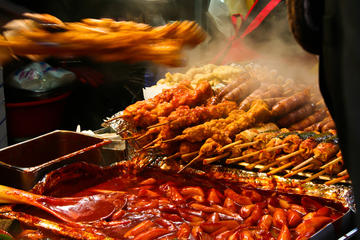 Gwangjang Market
Gwangjang Market Gwangjang Market, Seoul’s first and oldest covered market, was originally the place to come to buy traditional Korean clothing items, like hanbok. While the market still specializes in textiles, it’s become one of Seoul’s biggest street food hot spots, where foodies can sample nea
Gwangjang Market
Gwangjang Market Gwangjang Market, Seoul’s first and oldest covered market, was originally the place to come to buy traditional Korean clothing items, like hanbok. While the market still specializes in textiles, it’s become one of Seoul’s biggest street food hot spots, where foodies can sample nea
-
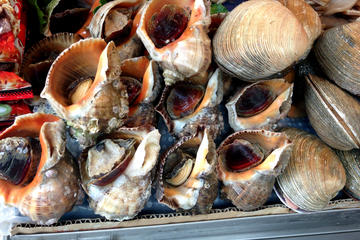 Gwangbokdong Street
Gwangbokdong Street Busan’s version of Oxford Street, Gwangbokdong Street is a true shopping mecca. Stretching from the foot of Yongdusan Park to Gukje Market, there are well over 100 shops selling everything from cutesy phone cases to folk crafts and high-end cosmetics. Shopping in South Kor
Gwangbokdong Street
Gwangbokdong Street Busan’s version of Oxford Street, Gwangbokdong Street is a true shopping mecca. Stretching from the foot of Yongdusan Park to Gukje Market, there are well over 100 shops selling everything from cutesy phone cases to folk crafts and high-end cosmetics. Shopping in South Kor
-
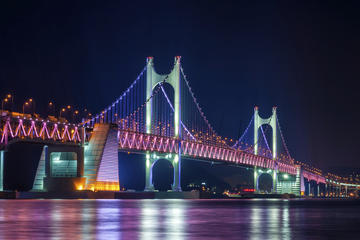 Gwangan Bridge
Gwangan Bridge The cover star of just about every city tourism poster since it opened in 2003, Gwangan Bridge is the Golden Gate of Busan. Beautiful day or night, Gwangan Bridge is best viewed from popular Gwangalli Beach, where lots of families and couples come to enjoy the sea air and to watch G
Gwangan Bridge
Gwangan Bridge The cover star of just about every city tourism poster since it opened in 2003, Gwangan Bridge is the Golden Gate of Busan. Beautiful day or night, Gwangan Bridge is best viewed from popular Gwangalli Beach, where lots of families and couples come to enjoy the sea air and to watch G
-
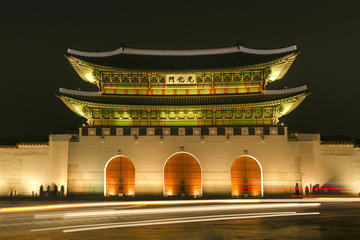 Gate Gwanghwamun
Gate Gwanghwamun Originally built in 1395 by the first Joseon king, Gwanghwamun serves as the main gate of Seoul’s Gyeongbukgung Palace, the largest of the five Joseon Dynasty palaces. The granite gate stood until the Japanese invasion of 1592, when the gate and the palace were burned and abandone
Gate Gwanghwamun
Gate Gwanghwamun Originally built in 1395 by the first Joseon king, Gwanghwamun serves as the main gate of Seoul’s Gyeongbukgung Palace, the largest of the five Joseon Dynasty palaces. The granite gate stood until the Japanese invasion of 1592, when the gate and the palace were burned and abandone
-
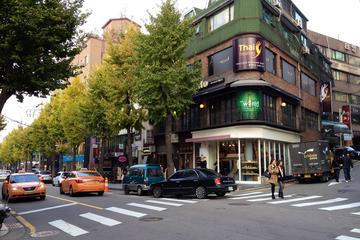 Garosu-gil
Garosu-gil Garosu-gil, meaning “tree-lined street” in Korean, is a 700-meter-long street in the trendy Gangnam neighborhood of Seoul. Just like the name suggests, the street is lined with gingko trees, whose leaves offer shade in the summer and make for a colorful display in fall. Whether you are
Garosu-gil
Garosu-gil Garosu-gil, meaning “tree-lined street” in Korean, is a 700-meter-long street in the trendy Gangnam neighborhood of Seoul. Just like the name suggests, the street is lined with gingko trees, whose leaves offer shade in the summer and make for a colorful display in fall. Whether you are
-
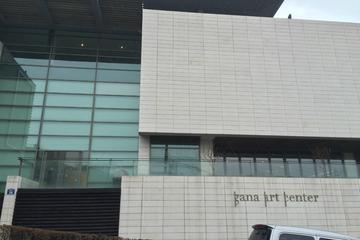 Gana Art Gallery
Gana Art Gallery The Gana Art Gallery is located in the residential area of Pyeongchang-dong, in the foothills of Mount Bukhansan. It’s the largest exhibition space in South Korea, featuring three halls showcasing over 400 exhibitions. The first exhibition hall features international works from th
Gana Art Gallery
Gana Art Gallery The Gana Art Gallery is located in the residential area of Pyeongchang-dong, in the foothills of Mount Bukhansan. It’s the largest exhibition space in South Korea, featuring three halls showcasing over 400 exhibitions. The first exhibition hall features international works from th
-
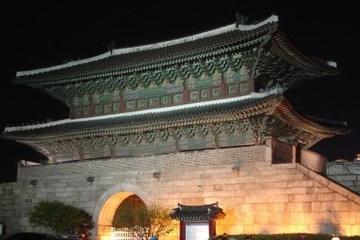 Dongdaemun Market and Gate
Dongdaemun Market and Gate Once the easternmost of four main gates to the capital city, Seoul, the Dongdaemun Gate functions today as a tourist attraction and an iconic beacon for shoppers seeking the wares available at the nearby market and shopping complexes.There have been imposing structures s
Dongdaemun Market and Gate
Dongdaemun Market and Gate Once the easternmost of four main gates to the capital city, Seoul, the Dongdaemun Gate functions today as a tourist attraction and an iconic beacon for shoppers seeking the wares available at the nearby market and shopping complexes.There have been imposing structures s
-
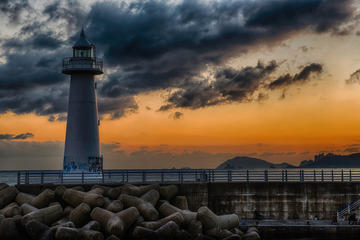 Dongbaek Island (Dongbaekseom)
Dongbaek Island (Dongbaekseom) Deongbeak Island (Dongbaekseom), considered one of Busan’s most scenic places, isn’t really an island at all. The former island, now connected to the Korean mainland by a land bridge made up of accumulated sediment, gets its name from the abundant dongbaek trees that
Dongbaek Island (Dongbaekseom)
Dongbaek Island (Dongbaekseom) Deongbeak Island (Dongbaekseom), considered one of Busan’s most scenic places, isn’t really an island at all. The former island, now connected to the Korean mainland by a land bridge made up of accumulated sediment, gets its name from the abundant dongbaek trees that
-
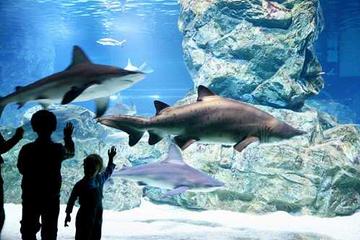 COEX Mall and Aquarium
COEX Mall and Aquarium Asias largest underground shopping mall, the COEX Mall, spans nearly a million square feet. It is located along subway line 2, underneath the COEX Convention and Exhibition Centre and near the overarching body that makes up the greater South Korean World Trade Centre complex
COEX Mall and Aquarium
COEX Mall and Aquarium Asias largest underground shopping mall, the COEX Mall, spans nearly a million square feet. It is located along subway line 2, underneath the COEX Convention and Exhibition Centre and near the overarching body that makes up the greater South Korean World Trade Centre complex
-
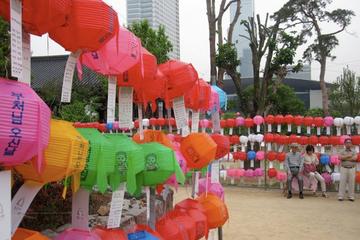 Bongeunsa Temple
Bongeunsa Temple Originally constructed in the 10th century, Bongeunsa Temple, once known as Gyeonseongsa Temple, is a popular Buddhist temple in Seoul. Considered the epicenter of the Seon sect of the religion, it is both a living ornament and cultural gem of the city. It is also an important bre
Bongeunsa Temple
Bongeunsa Temple Originally constructed in the 10th century, Bongeunsa Temple, once known as Gyeonseongsa Temple, is a popular Buddhist temple in Seoul. Considered the epicenter of the Seon sect of the religion, it is both a living ornament and cultural gem of the city. It is also an important bre
-
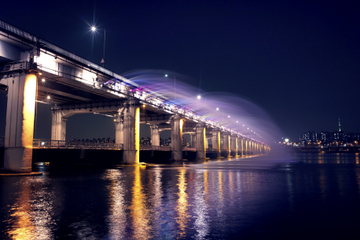 Banpo Bridge
Banpo Bridge Banpo Bridge passes over the Han River in downtown Seoul, connecting the Yongsan and Seocho neighborhoods. The girder bridge, completed in 1982, didn’t become an attraction in Seoul until 2009 when the Moonlight Rainbow Fountain was installed.Holding the Guinness Book of World Records
Banpo Bridge
Banpo Bridge Banpo Bridge passes over the Han River in downtown Seoul, connecting the Yongsan and Seocho neighborhoods. The girder bridge, completed in 1982, didn’t become an attraction in Seoul until 2009 when the Moonlight Rainbow Fountain was installed.Holding the Guinness Book of World Records
-
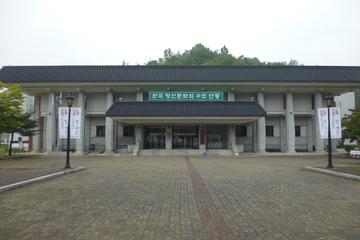 Andong Folk Museum
Andong Folk Museum Andong Folk Museum is the perfect place to get acquainted with Andong’s ancient culture and traditions. Next door to Andong Folk Village, the museum contains over 3,700 artifacts. From traditional clothing to pottery dating back to the Joseon Dynasty (1392 - 1897), as you wander
Andong Folk Museum
Andong Folk Museum Andong Folk Museum is the perfect place to get acquainted with Andong’s ancient culture and traditions. Next door to Andong Folk Village, the museum contains over 3,700 artifacts. From traditional clothing to pottery dating back to the Joseon Dynasty (1392 - 1897), as you wander
-
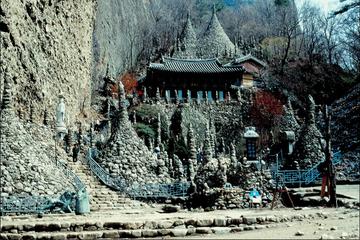 Tapsa Temple
Tapsa Temple Lee Gapyong, a retired scholar and hermit living in Maisan Mountain created some 120 pagodas from neatly piling stones on atop another. According to local lore, Lee Gapyong built the structures by himself over the course of three decades during the late 1800s, collecting stones by day
Tapsa Temple
Tapsa Temple Lee Gapyong, a retired scholar and hermit living in Maisan Mountain created some 120 pagodas from neatly piling stones on atop another. According to local lore, Lee Gapyong built the structures by himself over the course of three decades during the late 1800s, collecting stones by day
-
 Taekwondo Park
Taekwondo Park The Taekwondo Park in Muju, South Korea, opened in April 2014. It’s a unique site where Taekwondo practitioners from all over the world come to compete and train, and where visitors come to learn more about this popular martial art. It also celebrates the history, culture, and spiri
Taekwondo Park
Taekwondo Park The Taekwondo Park in Muju, South Korea, opened in April 2014. It’s a unique site where Taekwondo practitioners from all over the world come to compete and train, and where visitors come to learn more about this popular martial art. It also celebrates the history, culture, and spiri
-
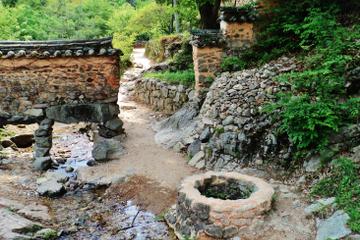 Soswaewon Garden
Soswaewon Garden The Soswaewon Garden in South Korea dates back to the 1500s when it was constructed by Yang Sanbo. A stone and mud wall surrounds the garden, with three inscribed stone and wooden panels built into it, including a board at the entrance displaying Kim Inhus poem praising the garden
Soswaewon Garden
Soswaewon Garden The Soswaewon Garden in South Korea dates back to the 1500s when it was constructed by Yang Sanbo. A stone and mud wall surrounds the garden, with three inscribed stone and wooden panels built into it, including a board at the entrance displaying Kim Inhus poem praising the garden
-
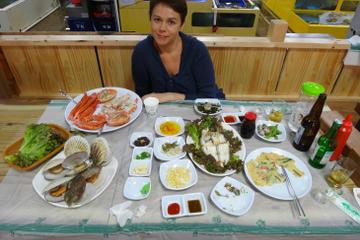 Sokcho Jungang Market
Sokcho Jungang Market Located in Sokcho City in South Korea’s Gangwon Province, the Sokcho Jungang Market is a quintessential Korean market specializing in fish, chicken and fresh fruits. Locals come to shop for groceries, and even if you’re not planning to cook, the market is an entertaining plac
Sokcho Jungang Market
Sokcho Jungang Market Located in Sokcho City in South Korea’s Gangwon Province, the Sokcho Jungang Market is a quintessential Korean market specializing in fish, chicken and fresh fruits. Locals come to shop for groceries, and even if you’re not planning to cook, the market is an entertaining plac
-
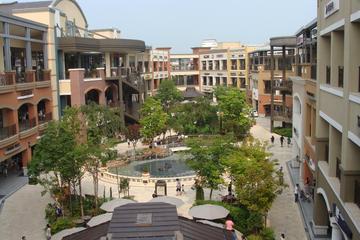 Paju Premium Outlets
Paju Premium Outlets The Paju Premium Outlets is a luxury shopping complex in Paju to the northwest of Seoul. This three-storey building is home to 220 outlet stores, with a mixture of international and designer brand names, plus local retailers. The complex is known for its discounted produc
Paju Premium Outlets
Paju Premium Outlets The Paju Premium Outlets is a luxury shopping complex in Paju to the northwest of Seoul. This three-storey building is home to 220 outlet stores, with a mixture of international and designer brand names, plus local retailers. The complex is known for its discounted produc
-
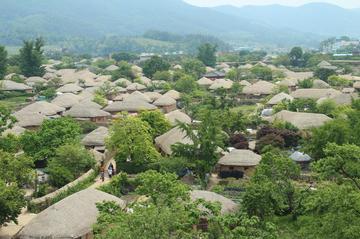 Nagan Eupseong Folk Village
Nagan Eupseong Folk Village Nagan Eupseong Folk Village, located in Jeollanam-do Province, encompasses one of the best preserved walled fortress town of the Chosun period. While there were 96 town fortresses in more than 330 of these towns at the height of the Chosun Dynasty, many of them were des
Nagan Eupseong Folk Village
Nagan Eupseong Folk Village Nagan Eupseong Folk Village, located in Jeollanam-do Province, encompasses one of the best preserved walled fortress town of the Chosun period. While there were 96 town fortresses in more than 330 of these towns at the height of the Chosun Dynasty, many of them were des
-
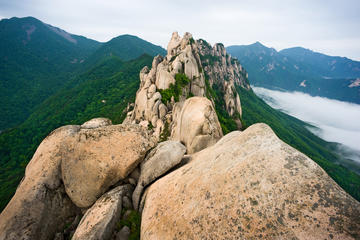 Mt Seorak
Mt Seorak Seoraksan National Park, one of the most scenic parks on the Korean peninsula and a UNESCO Biosphere Protected site, is home to Mt. Seorak, South Korea’s third tallest mountain at 5,604 feet (1,708 meters). Since it became a national monument in 1965, Mt. Seorak (Snowy Peak Mountain) has
Mt Seorak
Mt Seorak Seoraksan National Park, one of the most scenic parks on the Korean peninsula and a UNESCO Biosphere Protected site, is home to Mt. Seorak, South Korea’s third tallest mountain at 5,604 feet (1,708 meters). Since it became a national monument in 1965, Mt. Seorak (Snowy Peak Mountain) has
-
 Hanji Theme Park
Hanji Theme Park The Hanji Theme Park is located in Wonju, a city in South Korea’s Gangwon province and home to the annual Hanji Festival. Hanji (literally meaning ‘Korean paper’) is handmade from the inner bark of mulberry trees; it’s an ancient and complicated process, and therefore it’s said t
Hanji Theme Park
Hanji Theme Park The Hanji Theme Park is located in Wonju, a city in South Korea’s Gangwon province and home to the annual Hanji Festival. Hanji (literally meaning ‘Korean paper’) is handmade from the inner bark of mulberry trees; it’s an ancient and complicated process, and therefore it’s said t
Total
823 -travel
FirstPage PreviousPage NextPage LastPage CurrentPage:
2/42 20-travel/Page GoTo Page:
 Gwangjang Market
Gwangjang Market Gwangjang Market, Seoul’s first and oldest covered market, was originally the place to come to buy traditional Korean clothing items, like hanbok. While the market still specializes in textiles, it’s become one of Seoul’s biggest street food hot spots, where foodies can sample nea
Gwangjang Market
Gwangjang Market Gwangjang Market, Seoul’s first and oldest covered market, was originally the place to come to buy traditional Korean clothing items, like hanbok. While the market still specializes in textiles, it’s become one of Seoul’s biggest street food hot spots, where foodies can sample nea
 Gwangbokdong Street
Gwangbokdong Street Busan’s version of Oxford Street, Gwangbokdong Street is a true shopping mecca. Stretching from the foot of Yongdusan Park to Gukje Market, there are well over 100 shops selling everything from cutesy phone cases to folk crafts and high-end cosmetics. Shopping in South Kor
Gwangbokdong Street
Gwangbokdong Street Busan’s version of Oxford Street, Gwangbokdong Street is a true shopping mecca. Stretching from the foot of Yongdusan Park to Gukje Market, there are well over 100 shops selling everything from cutesy phone cases to folk crafts and high-end cosmetics. Shopping in South Kor
 Gwangan Bridge
Gwangan Bridge The cover star of just about every city tourism poster since it opened in 2003, Gwangan Bridge is the Golden Gate of Busan. Beautiful day or night, Gwangan Bridge is best viewed from popular Gwangalli Beach, where lots of families and couples come to enjoy the sea air and to watch G
Gwangan Bridge
Gwangan Bridge The cover star of just about every city tourism poster since it opened in 2003, Gwangan Bridge is the Golden Gate of Busan. Beautiful day or night, Gwangan Bridge is best viewed from popular Gwangalli Beach, where lots of families and couples come to enjoy the sea air and to watch G
 Gate Gwanghwamun
Gate Gwanghwamun Originally built in 1395 by the first Joseon king, Gwanghwamun serves as the main gate of Seoul’s Gyeongbukgung Palace, the largest of the five Joseon Dynasty palaces. The granite gate stood until the Japanese invasion of 1592, when the gate and the palace were burned and abandone
Gate Gwanghwamun
Gate Gwanghwamun Originally built in 1395 by the first Joseon king, Gwanghwamun serves as the main gate of Seoul’s Gyeongbukgung Palace, the largest of the five Joseon Dynasty palaces. The granite gate stood until the Japanese invasion of 1592, when the gate and the palace were burned and abandone
 Garosu-gil
Garosu-gil Garosu-gil, meaning “tree-lined street” in Korean, is a 700-meter-long street in the trendy Gangnam neighborhood of Seoul. Just like the name suggests, the street is lined with gingko trees, whose leaves offer shade in the summer and make for a colorful display in fall. Whether you are
Garosu-gil
Garosu-gil Garosu-gil, meaning “tree-lined street” in Korean, is a 700-meter-long street in the trendy Gangnam neighborhood of Seoul. Just like the name suggests, the street is lined with gingko trees, whose leaves offer shade in the summer and make for a colorful display in fall. Whether you are
 Gana Art Gallery
Gana Art Gallery The Gana Art Gallery is located in the residential area of Pyeongchang-dong, in the foothills of Mount Bukhansan. It’s the largest exhibition space in South Korea, featuring three halls showcasing over 400 exhibitions. The first exhibition hall features international works from th
Gana Art Gallery
Gana Art Gallery The Gana Art Gallery is located in the residential area of Pyeongchang-dong, in the foothills of Mount Bukhansan. It’s the largest exhibition space in South Korea, featuring three halls showcasing over 400 exhibitions. The first exhibition hall features international works from th
 Dongdaemun Market and Gate
Dongdaemun Market and Gate Once the easternmost of four main gates to the capital city, Seoul, the Dongdaemun Gate functions today as a tourist attraction and an iconic beacon for shoppers seeking the wares available at the nearby market and shopping complexes.There have been imposing structures s
Dongdaemun Market and Gate
Dongdaemun Market and Gate Once the easternmost of four main gates to the capital city, Seoul, the Dongdaemun Gate functions today as a tourist attraction and an iconic beacon for shoppers seeking the wares available at the nearby market and shopping complexes.There have been imposing structures s
 Dongbaek Island (Dongbaekseom)
Dongbaek Island (Dongbaekseom) Deongbeak Island (Dongbaekseom), considered one of Busan’s most scenic places, isn’t really an island at all. The former island, now connected to the Korean mainland by a land bridge made up of accumulated sediment, gets its name from the abundant dongbaek trees that
Dongbaek Island (Dongbaekseom)
Dongbaek Island (Dongbaekseom) Deongbeak Island (Dongbaekseom), considered one of Busan’s most scenic places, isn’t really an island at all. The former island, now connected to the Korean mainland by a land bridge made up of accumulated sediment, gets its name from the abundant dongbaek trees that
 COEX Mall and Aquarium
COEX Mall and Aquarium Asias largest underground shopping mall, the COEX Mall, spans nearly a million square feet. It is located along subway line 2, underneath the COEX Convention and Exhibition Centre and near the overarching body that makes up the greater South Korean World Trade Centre complex
COEX Mall and Aquarium
COEX Mall and Aquarium Asias largest underground shopping mall, the COEX Mall, spans nearly a million square feet. It is located along subway line 2, underneath the COEX Convention and Exhibition Centre and near the overarching body that makes up the greater South Korean World Trade Centre complex
 Bongeunsa Temple
Bongeunsa Temple Originally constructed in the 10th century, Bongeunsa Temple, once known as Gyeonseongsa Temple, is a popular Buddhist temple in Seoul. Considered the epicenter of the Seon sect of the religion, it is both a living ornament and cultural gem of the city. It is also an important bre
Bongeunsa Temple
Bongeunsa Temple Originally constructed in the 10th century, Bongeunsa Temple, once known as Gyeonseongsa Temple, is a popular Buddhist temple in Seoul. Considered the epicenter of the Seon sect of the religion, it is both a living ornament and cultural gem of the city. It is also an important bre
 Banpo Bridge
Banpo Bridge Banpo Bridge passes over the Han River in downtown Seoul, connecting the Yongsan and Seocho neighborhoods. The girder bridge, completed in 1982, didn’t become an attraction in Seoul until 2009 when the Moonlight Rainbow Fountain was installed.Holding the Guinness Book of World Records
Banpo Bridge
Banpo Bridge Banpo Bridge passes over the Han River in downtown Seoul, connecting the Yongsan and Seocho neighborhoods. The girder bridge, completed in 1982, didn’t become an attraction in Seoul until 2009 when the Moonlight Rainbow Fountain was installed.Holding the Guinness Book of World Records
 Andong Folk Museum
Andong Folk Museum Andong Folk Museum is the perfect place to get acquainted with Andong’s ancient culture and traditions. Next door to Andong Folk Village, the museum contains over 3,700 artifacts. From traditional clothing to pottery dating back to the Joseon Dynasty (1392 - 1897), as you wander
Andong Folk Museum
Andong Folk Museum Andong Folk Museum is the perfect place to get acquainted with Andong’s ancient culture and traditions. Next door to Andong Folk Village, the museum contains over 3,700 artifacts. From traditional clothing to pottery dating back to the Joseon Dynasty (1392 - 1897), as you wander
 Tapsa Temple
Tapsa Temple Lee Gapyong, a retired scholar and hermit living in Maisan Mountain created some 120 pagodas from neatly piling stones on atop another. According to local lore, Lee Gapyong built the structures by himself over the course of three decades during the late 1800s, collecting stones by day
Tapsa Temple
Tapsa Temple Lee Gapyong, a retired scholar and hermit living in Maisan Mountain created some 120 pagodas from neatly piling stones on atop another. According to local lore, Lee Gapyong built the structures by himself over the course of three decades during the late 1800s, collecting stones by day
 Taekwondo Park
Taekwondo Park The Taekwondo Park in Muju, South Korea, opened in April 2014. It’s a unique site where Taekwondo practitioners from all over the world come to compete and train, and where visitors come to learn more about this popular martial art. It also celebrates the history, culture, and spiri
Taekwondo Park
Taekwondo Park The Taekwondo Park in Muju, South Korea, opened in April 2014. It’s a unique site where Taekwondo practitioners from all over the world come to compete and train, and where visitors come to learn more about this popular martial art. It also celebrates the history, culture, and spiri
 Soswaewon Garden
Soswaewon Garden The Soswaewon Garden in South Korea dates back to the 1500s when it was constructed by Yang Sanbo. A stone and mud wall surrounds the garden, with three inscribed stone and wooden panels built into it, including a board at the entrance displaying Kim Inhus poem praising the garden
Soswaewon Garden
Soswaewon Garden The Soswaewon Garden in South Korea dates back to the 1500s when it was constructed by Yang Sanbo. A stone and mud wall surrounds the garden, with three inscribed stone and wooden panels built into it, including a board at the entrance displaying Kim Inhus poem praising the garden
 Sokcho Jungang Market
Sokcho Jungang Market Located in Sokcho City in South Korea’s Gangwon Province, the Sokcho Jungang Market is a quintessential Korean market specializing in fish, chicken and fresh fruits. Locals come to shop for groceries, and even if you’re not planning to cook, the market is an entertaining plac
Sokcho Jungang Market
Sokcho Jungang Market Located in Sokcho City in South Korea’s Gangwon Province, the Sokcho Jungang Market is a quintessential Korean market specializing in fish, chicken and fresh fruits. Locals come to shop for groceries, and even if you’re not planning to cook, the market is an entertaining plac
 Paju Premium Outlets
Paju Premium Outlets The Paju Premium Outlets is a luxury shopping complex in Paju to the northwest of Seoul. This three-storey building is home to 220 outlet stores, with a mixture of international and designer brand names, plus local retailers. The complex is known for its discounted produc
Paju Premium Outlets
Paju Premium Outlets The Paju Premium Outlets is a luxury shopping complex in Paju to the northwest of Seoul. This three-storey building is home to 220 outlet stores, with a mixture of international and designer brand names, plus local retailers. The complex is known for its discounted produc
 Nagan Eupseong Folk Village
Nagan Eupseong Folk Village Nagan Eupseong Folk Village, located in Jeollanam-do Province, encompasses one of the best preserved walled fortress town of the Chosun period. While there were 96 town fortresses in more than 330 of these towns at the height of the Chosun Dynasty, many of them were des
Nagan Eupseong Folk Village
Nagan Eupseong Folk Village Nagan Eupseong Folk Village, located in Jeollanam-do Province, encompasses one of the best preserved walled fortress town of the Chosun period. While there were 96 town fortresses in more than 330 of these towns at the height of the Chosun Dynasty, many of them were des
 Mt Seorak
Mt Seorak Seoraksan National Park, one of the most scenic parks on the Korean peninsula and a UNESCO Biosphere Protected site, is home to Mt. Seorak, South Korea’s third tallest mountain at 5,604 feet (1,708 meters). Since it became a national monument in 1965, Mt. Seorak (Snowy Peak Mountain) has
Mt Seorak
Mt Seorak Seoraksan National Park, one of the most scenic parks on the Korean peninsula and a UNESCO Biosphere Protected site, is home to Mt. Seorak, South Korea’s third tallest mountain at 5,604 feet (1,708 meters). Since it became a national monument in 1965, Mt. Seorak (Snowy Peak Mountain) has
 Hanji Theme Park
Hanji Theme Park The Hanji Theme Park is located in Wonju, a city in South Korea’s Gangwon province and home to the annual Hanji Festival. Hanji (literally meaning ‘Korean paper’) is handmade from the inner bark of mulberry trees; it’s an ancient and complicated process, and therefore it’s said t
Hanji Theme Park
Hanji Theme Park The Hanji Theme Park is located in Wonju, a city in South Korea’s Gangwon province and home to the annual Hanji Festival. Hanji (literally meaning ‘Korean paper’) is handmade from the inner bark of mulberry trees; it’s an ancient and complicated process, and therefore it’s said t